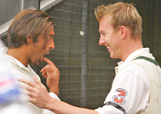COACHING
Bowling in ODIs - Part I
- By SP. Bhatia Cricket today has become more of a batsman's game than ever before, the limited-overs version even more so. Bowlers are treated very cruelly in one-day internationals, and that is putting it mildly. The conditions and pressure that a bowler encounters in ODIs are far different from those in Test cricket. One-day cricket calls for different mental demands. The strategies adopted by the bowlers in ODIs are not merely governed by whether they are bowling first or second, but by various other factors, like:Fielding positions
Type of ball
Over-restrictions for each bowler
The batsman's abilities and intentions
Pitch
Each of these factors needs to be examined and analysed to clearly define the strategies and roles of the bowlers.
Fielding positions:
The fielding restrictions in one-day cricket permit only two fielders outside the 30-yards circle. Of the seven fielders in the circle, two have to stand in stationary catching positions. The 'catchers' mainly play a run-saving role. The men who stand in the slips in the first few overs are shifted to leg-slip or short mid-wicket. The slips are thus left vacant, even in the first 15 overs. Imagine the predicament faced by a quick bowler who may be proficient in inducing the batsmen to edge the ball, only to be gobbled up by the slips. The gaping hole in the slip-cordon will force him to make adjustments, and he might lose his rhythm and even his pace as a result.The key in such situations is to maintain a good line and length and not experiment a lot. This is crucial, as the batsman can easily loft the ball over the infield due to the fielding restrictions.
Having the right positions in the outfield is of utmost importance. Usually, the bowlers and captains tend to keep the two men at third-man on the off-side and fine-leg on the leg-side, irrespective of the type of bowling, batsman, and wicket. However, one should ideally take these three factors into consideration and then decide where to place the outfielders. A better bet would be to have a fielder at long off or long-on and then bowl full-length deliveries. But here again, accuracy has to be maintained. There should be different plans for different opposition batsmen.

Even they have been punished for
not being disciplined
enough...with the ball
The fielding restrictions are relaxed
after the 15th over. However, atleast four men have to stand within the
30-yards circle throughout the innings. It is advisable to keep as many
fielders as possible in single-saving positions and make the batsmen work
harder for their runs. The aim of every fielding captain should be to strike a
balance between an attacking and defensive field.
The bowlers should be 'disciplined'. Bowling on one side of the wicket will help if the field has been appropriately set. A bowler will be slaughtered if he does not 'bowl to his field'. Even tornados like Brett Lee and Shoaib Akhtar have copped harsh treatment whenever their bowling has fallen short of the 'disciplined' mark! Remember Sachin Tendulkar's assault on Shoaib in the 2003 World Cup game between India and Pakistan?
The bowlers should be 'disciplined'. Bowling on one side of the wicket will help if the field has been appropriately set. A bowler will be slaughtered if he does not 'bowl to his field'. Even tornados like Brett Lee and Shoaib Akhtar have copped harsh treatment whenever their bowling has fallen short of the 'disciplined' mark! Remember Sachin Tendulkar's assault on Shoaib in the 2003 World Cup game between India and Pakistan?
Type of ball: Matches played with coloured clothing require a ball of a different colour; white. Some of these matches are played under floodlights. Originally, the white ball was lacquered and did not swing at all. It was also a lot harder than the traditional red cherry. However, the white balls that are used today are more similar to the red ones. They swing a little bit if the conditions are conducive, but still not as much as the red cherry.
A bowler needs to feel comfortable bowling with a white ball if he has to be accurate with it. This means that he needs to practice in the nets. If he doesn't, he might well be in for a lot of agony and distress during the actual match. He could find it difficult to control the swing and spray the ball all over the place. The batsmen certainly won't complain!
To be continued... Bowling in ODIs - Part II